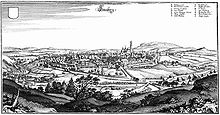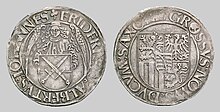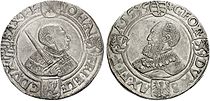Annaberg Mint


The Annaberg mint, founded in 1498 during the reign of Duke Albrecht the Courageous ( Albertine Saxony) and Elector Frederick the Wise ( Ernestine Saxony) was in Frohnau until the end of 1501 and in Annaberg from 1502 . With the establishment of the Dresden mint , Elector August (1553–1586) had all state coins closed. The Annaberg mint had to cease operations in 1558.
history
The mint in Frohnau
In 1492 the Schreckenberg had struck gold. The rich silver yield from its mines led to the founding of the mountain town of Annaberg. In 1496, Duke Georg founded the "Neustadt am Schreckenberg", which was later named St. Annaberg. The mint, initially operated in Frohnau since 1498, is mentioned in Annaberg's chronicle in 1746:
"[...] Because on this mountain the mine, as just told, found what it was looking for and afterwards the well-known angel pennies were minted from such a yield, which, because they were struck down in the mill on Schreckenberg, had an angel on one side , which holds a millstone, but the princely coat of arms is embossed on the other side [...]. "
The angel mentioned in the chronicle on the Schreckenbergers does not hold a millstone, but the spa coat of arms. In his "Saxon Coin Studies", Walther Haupt mentions angel groschen in the following context with millstones:
“[…] On the one hand they bear the ore machine insignia, the Kurschwerter, held by an angel in a shield, after which they were also named angel groschen, on the other hand the five-part coat of arms of the dukes of Saxony. In joking exaggeration, they were given the name millstones because of their size. "
Another variant of the designation and description of the Annaberg large groschen and a reference to the location of the mint in Frohnau is contained in August Schumann's State Lexicon from 1816:
“At Frohnau, of the silver won in the Schottenberge and Schreckenberge, the so-called Schreckenbergers were first minted in 1498 and 1499; This type of money got this name from the place where the silver was extracted; Because of their character, they were also called angel groschen, and, because the mint was right next to the village mill, millstones as well. There are no remains of this mint, but there are of old smelting works, not in the village itself, but in the so-called Frohnau or Hüttengrunde. [...] Now you can see a well-equipped Zainhammer at the foot of the Schottenberg on the Sehmeflüßchen ; it should stand on the place of the former coin. "
An article by Paul Arnold provides a comprehensive explanation of the different names of the large groschen and how the coin was stored until its own building in Annaberg was completed:
"[...] This new coin, mainly intended for the payment of silver to the mining trades, is known under three different names: 1. Schreckenberger , after the place where their silver was found on the Schreckenberg, 2. Angel groschen after the angel as a sign holder on the front and 3. Millstones after its mint in the Hammermühle zu Frohnau, where this newly constructed coin was temporarily housed from 1498 until its own building was completed in 1501. "
According to Johann Friedrich Klotzsch, the reason why the mint was temporarily set up and operated in Frohnau in the village's "grinding mill" is:
"[...] Because the new mine with non-simultaneous yield worthwhile than could be thought of the construction of a new city, the mint was meanwhile transferred to the grinding mill of the village Frohnau."
According to Klotzsch, “old guesswork”, “the first mint of these new groschen” (meaning Schreckenberger) “ran out at the time when the mint existed in Frohnau. Because, apart from this, there would otherwise be no reasonable reason to understand why those of old age [...] should also have been called millstones. ” Erbstein also cited the large groschen as the reason for this contemporary designation,“ because the same was due to the lack of a coin workshop in the mill of the Village of Frohnau with a hammer. "
The mint in Annaberg

The Frohnau Mint was moved to Annaberg as early as 1502. The new mint is mentioned in the Annaberg Chronicle of 1646:
“The Mining Authority House, in which everything related to the mining industry is negotiated, where miners are heard with their complaints, mountain bills are kept and the exploits are distributed, was built close to the mountain chapel, and in the back in the courtyard the coin, among other coins the well-known "Schreckenberger" were minted, where on one side an angel holding a coat of arms, on the other side the Saxon coat of arms is stamped [...] "
From the silver of the Schreckenberg pits, the new Schreckenberger Groschen (also called Schreckenberger, Schreckenberger Engelgroschen and Annenberger), named after him, were produced in accordance with the coinage of August 18, 1498 with a fineness of 861/1000 and seven of them were on the Rhenish gold florins to be expected. Until 1534, the Schreckenberger were considered three penny pieces or 1 ⁄ 7 guilders (thalers). They were minted in Saxony and Thuringia until 1571, most recently in the mints of Dresden and Saalfeld , in Annaberg only until 1547.
First silver guilders
The Saxon silver yield in 1500 was so great that it could no longer be countered with the expression of groschen and Schreckenbergers.
The preparation for the introduction of the large silver currency began with the coin day in Zeitz on August 9, 1490. The first result was the beard groschen . A silver equivalent of 27.464 g of fine silver was specified for the Rhenish gold guilder :
- 21 beard groschen (27.464 g fine silver) = 1 Rhenish guilder (2.527 g fine gold )
The definition of the 1:21 value ratio between groschen and gold guilders was also retained with the introduction of large silver coins, the silver guilders ( thalers ).
The first Saxon large silver coins, the guilders (gold groschen, gold groschen, thaler ) were minted only in the Annaberg / Frohnau mint and possibly in the Wittenberg mint in 1500 . The Freiberg and Leipzig mints are demonstrably eliminated, the Buchholz mint did not work until 1505, the Schneeberg mint was closed from 1498 to 1501 and the one in Zwickau from 1493 to 1530.
The minting of the new guilders under Friedrich the Wise, Albrecht dem Beherzten and Johann took place according to the Saxon coinage system of 1500 (8.53 guilders a. D. F. Mark, weight 29.23 g, fine weight 27.41 g, purity 937.5 / 1000). The fine weight of the silver guilder corresponded in value to the gold value of the Rhenish gold guilder at that time. On one side they bear the bust of Elector Friedrich III. and on the other the juxtaposed half-length portraits of dukes Albrecht and Johann.
From 1505 to 1525 the gulden was minted according to the changed standard from 1505: 8.59 gulden a. d. f. Mark, weight: 29.23 g, fine weight: 27.20 g, fineness: 930.56 / 1000.
Dating of the fold-up hats
The silver guilders, the so-called Klappmützentaler , were struck from 1500 to 1525. Elector Friedrich III. coined from 1486 to 1500 jointly with his brother Johann and with Duke Albrecht.
- The first silver guilders no year (1500) with Duke Albrecht are extremely rare.
- After Albrecht's death in 1500, the guilders were minted until 1507 with the order of the princely names Friedrich, Georg and Johann in the romanization.
- From 1507 to 1525 with the changed order Friedrich, Johann and Georg. The change in the order of the assumption of princes on the coins was made because the councilors of the elector asserted that up to now in Saxony the principle that the ruling prince precedes the non-ruling prince on the coin inscriptions was not implemented, but only the age of the prince was decisive .
For the undated guilders without a mintmaster's mark, this results in a time allocation.
Relocation to Dresden
When he checked the coins in his mints in Freiberg, Annaberg and Schneeberg, Elector August found that the mint masters included the fine silver content, which, according to the regulations of the Saxon coinage system from 1549 (coin base from 1549 to 1558) for the guldengroschen (taler) 14 Lot 8 Grän (= 902.78 / 1000) had been set, had reduced it without authorization. The elector then had all state coins closed and transferred them to a single coin in Dresden, in the immediate vicinity of his residence palace , in order to be able to better monitor the correctness of the shot and grain .
The Annaberg mint was initially moved back to the local monastery in 1557 before it was merged with the Dresden Mint in 1558.
The nominal
In the period from 1498 to 1558, Heller , Pfennige, Dreipfennigteile (three), groschen ( 1 ⁄ 21 guldengroschen = interest groschen , ⅟ 16 guldengroschen = pointed groschen), Schreckenberger, ⅛ thaler, ¼ thaler, ½ thaler, thaler ( guilder groschen) were sold in the Annaberg mint from 1498 to 1558 ), Dick thaler and 1½fache Taler coined.
- Annaberg Guldengroschen
Duke Georg, Guldengroschen 1530 ( sole issue )
Elector Johann Friedrich and Duke Georg, Guldengroschen 1535
Elector Johann Friedrich and Duke Heinrich , Guldengroschen 1540
Elector Johann Friedrich and Duke Moritz , Guldengroschen 1542
The silver guilders or guilder groschen introduced in 1500 were worth 21 groschen. When the Saxon guldengroschen were set to 24 groschen in 1542, the ratio 1 gulden = 21 groschen was retained as the method of counting. A fictitious billing gulden was created (1 Meißnian gulden = 21 groschen).
Tipper and luffing time
In the time of money falsification, the tipper and wipper era , the monopoly of the Dresden Mint was broken with the establishment of tipper mints. Also in Annaberg continued from 1621 to 1623 under the mint master Michael Rothe, Mmz. Eichel am Zweig started the production of so-called interim or kipper coins, which was being carried out on an ever larger scale. That was groschen, 8, 10, 20, 30, 40 and 60 groschen pieces ( Kippertaler to 60 groschen).
As a coin image for the new coins, an angel was used on the obverse as a shield holder for the coat of arms of Electorate of Saxony and on the reverse two angels holding three coats of arms. The great similarity with the high-quality Schreckenberger or angel groschen minted in Saxony and Thuringia from 1498 to 1571 should make the Ursual coins popular in Electoral Saxony. The mint could not be objected to, because they were not taler coins or their parts, but groschen pieces, i.e. land coins , which did not have to comply with the imperial coinage system. The smallest coins, i.e. one-sided copper pennies, were produced by the Grünthal copper hammer .
Mint master of the Annaberg mint
| Mint master | from | to | Mintmaster's mark | comment |
|---|---|---|---|---|
| Augustin Horn | 1498 | 1500 | Shamrock | |
| Heinrich Stein | 1499 | 1511 | five-pointed star, crescent moon with star, without mm. | |
| Augustin Horn together with Heinrich Stein | 1500 | Shamrock and five-pointed star | ||
| Albrecht von Schreibersdorf | 1512 | 1523 | cross | |
| Melchior Irmisch | (1524) 1527 | 1532 | Shamrock | |
| Wolf Hünerkopf | 1533 | 1539 | Morning star | |
| Wolf Hünerkopf | 1542 | 1545 | six-pointed star | as an extra-official mint master for Johann Friedrich and Moritz |
| Nickel streubel | 1539 | 1545 | Cross in a circle | |
| Matthäus Rothe | 1545 | 1554 | Acorn on branch | |
| Leupold Holzschucher | 1554 | 1558 | Wooden shoe | Mint moved to Dresden in 1558 |
Around 1540 the letter ANB was used to mark the mint. The former Annaberg mint master Wolf Hünerkopf received the privilege of the Wettiners for his services to mint the silver obtained from his own St. Clement mine as an extra-official mint master in his house with his mint master's mark, the six-pointed star. This unique and unusual privilege explains the extreme rarity of these coins minted between 1542 and 1545.
See also
literature
- Walther Haupt : Saxon coinage. (= Work and research reports on the preservation of monuments in Saxony. 10). German Science Publishers, Berlin 1974.
- Paul Arnold: Walter Haupt and his "Sächsische Münzkunde" . In: Numismatic notebooks. No. 20, Dresden 1986.
- Julius Erbstein , Albert Erbstein : Discussions in the field of the Saxon coin and medal history when listing the Hofrath Engelhardt's collection. Dresden 1888.
- Heinz Fengler, Gerd Gierow, Willy Unger: transpress Lexicon Numismatics. transpress, Berlin 1976.
- Tristan Weber: The Saxon coinage from 1500 to 1571. H. Gietl, Regenstauf 2010, ISBN 978-3-86646-827-6 .
- Claus Keilitz: The Saxon Coins 1500–1547. H. Gietl, Regenstauf 2010, ISBN 978-3-86646-528-2 .
- Brockhaus travel guide Erzgebirge-Vogtland. Leipzig 1973.
Web links
- Timeline of the history of the Saxon mining industry. after Bachmann / Marx / Wächtler: The silver bottom. Leipzig / Stuttgart 1990.
- City and mining history of Annaberg-Buchholz, brief overview . ( Memento from May 12, 2009 in the Internet Archive ) Source: Günter Meier, Freiberg, On the creation of the “Im Gößner” visitor mine in Annaberg-Buchholz, Sächs. Heimatblätter 3/95, Bernd Lahl, Chemnitz, The History of Annaberg Mining, Lapis, No. 12/92.
Individual evidence
- ↑ Adam Daniel Richter: Chronica of the free mountain town of St. Annaberg. Volume 1, p. 30, Annaberg 1746/48 ( digital version ; PDF file; 4.78 MB)
- ^ Walther Haupt: Sächsische Münzkunde. Deutscher Verlag der Wissenschaften, Berlin 1974, p. 93.
- ↑ Frohnau. . In: August Schumann : Complete State, Post and Newspaper Lexicon of Saxony. 3rd volume. Schumann, Zwickau 1816, p. 12.
- ^ Paul Arnold: The Saxon Thaler Currency from 1500 to 1763. Swiss Numismatic Rundschau, Volume 59, 1980, p. 57.
- ^ Johann Friederich Klotzsch: Attempt of a Chur-Saxon coin history. From the oldest to the present. First part. Chemnitz 1779, p. 139.
- ^ Karl Friedrich Wilhelm Erbstein: Numismatic fragments in relation to Saxon history , Nacherinnerungen (1828), p. 126
- ↑ Anonymus: The Electoral Saxon. freye Bergstadt St. Annabergk […] Chronical records of Annaberg and the mine. Forays through the history of the Upper Ore Mountains. Issue 30. Annaberg-Buchholz 1995. (Copy of the "Annaberger Chronik 1646" by Michael Zirolt, edited by Helmut Unger ) Download (pdf 147 KB) ( Memento from July 19, 2011 in the Internet Archive )
- ↑ Walther Haupt: Sächsische Münzkunde , Berlin 1974, p. 89.
- ^ Gerhard Krug: The Meissnisch-Saxon Groschen 1338–1500 , Berlin 1974, p. 104.
- ↑ mcsearch: Elector Friedrich III. and the dukes Albrecht and Johann, Gulden undated (1500), Annaberg or Wittenberg
- ^ Paul Arnold: Walter Haupt and his "Saxon Coin Studies" . In: Numismatical Hefte No. 20, Dresden 1986, p. 54.
- ↑ coingallery.de: First Guldengroschen (hooded Taler) undated (1500) and without MMZ.. Schnee 1, Keilitz 4, Dav. 9705.
- ^ Walther Haupt: Sächsische Münzkunde. (= Work and research reports on the preservation of monuments in Saxony. 10). Deutscher Verlag der Wissenschaften, Berlin 1974, p. 98.
- ↑ mcsearch: Darin: George Duke, 1500-1539. 1½ times thaler 1527, Annaberg. Dav. 9784; Snow 659.
- ↑ Paul Arnold: The Saxon Thaler Currency from 1500 to 1763. Swiss Numismatic Rundschau, Volume 59, 1980, p. 64.
- ↑ mcsearch: Elector Johann Georg I, 60 Kipper Groschen 1622, Annaberg
- ^ Walther Haupt: Sächsische Münzkunde. Deutscher Verlag der Wissenschaften, Berlin 1974, p. 136.









